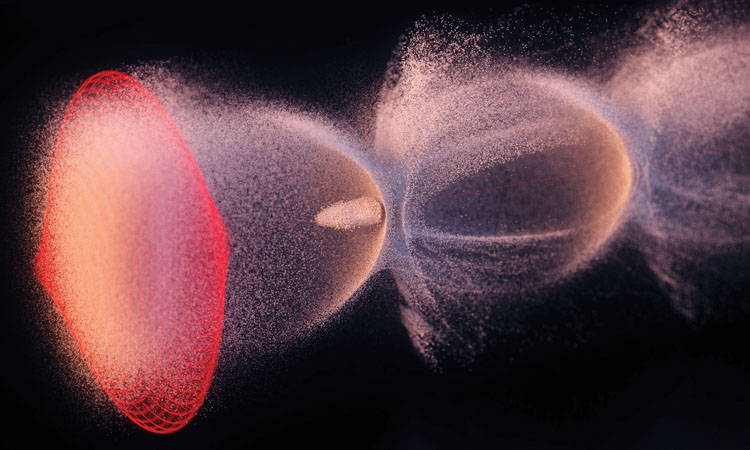 A rendering, based on simulation data, of an intense laser pulse (red) in an ionized gas driving a bubble-shaped plasma wave consisting of electrons (white). An electron bunch (center) rides the plasma wave, accelerated by the high electric fields. [DESY/Science Communication Lab]
A rendering, based on simulation data, of an intense laser pulse (red) in an ionized gas driving a bubble-shaped plasma wave consisting of electrons (white). An electron bunch (center) rides the plasma wave, accelerated by the high electric fields. [DESY/Science Communication Lab]
In July 2021, researchers at the Shanghai Institute of Optics and Fine Mechanics in China announced that they had used a free-electron laser (FEL) to generate extreme ultraviolet light. That wasn’t a big deal in itself; FELs already do so routinely, and at much shorter (X-ray) wavelengths and with greater intensities. What mattered instead was how the group achieved the feat. FELs commonly require machines several kilometers long that can cost billions of dollars to build. The Shanghai setup, in contrast, measured just 12 meters from end to end.
Wakefield devices exploit the properties of plasma to accelerate electrons via electric fields a thousand times stronger than those inside conventional RF cavities.
That’s because the Shanghai accomplishment was powered by a laser wakefield accelerator—showing, for the first time, that such a device can yield stimulated emission. For many scientists, the result marked an important milestone on the road to realizing practical wakefield accelerators—and signaled China’s rapid ascent in the field of high-power lasers.
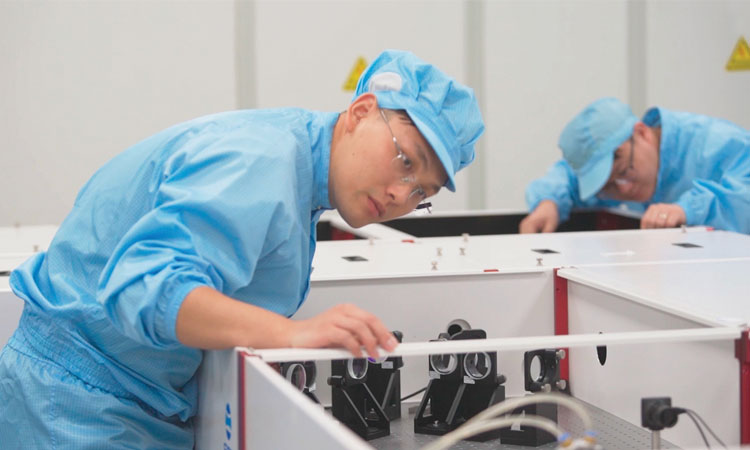 A researcher works on the optics of the Shanghai Institute of Optics and Fine Mechanics plasma-powered FEL. [Ke Feng]
A researcher works on the optics of the Shanghai Institute of Optics and Fine Mechanics plasma-powered FEL. [Ke Feng]
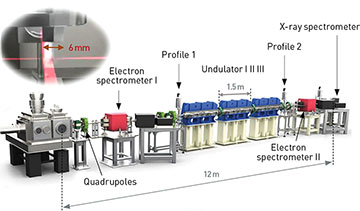 The laser-driven accelerator setup measures only 12 meters from end to end. Inset: Close-up of plasma accelerator, which is inside metal box at left. [Enlarge graphic] [Ke Feng]
The laser-driven accelerator setup measures only 12 meters from end to end. Inset: Close-up of plasma accelerator, which is inside metal box at left. [Enlarge graphic] [Ke Feng]
A typical FEL generates its exceptionally bright radiation pulses by accelerating electrons in a long series of RF cavities, and then oscillating the electrons using giant magnets. Wakefield devices instead accelerate electrons by exploiting the properties of plasma—being able to generate electric fields a thousand times stronger than those inside conventional cavities. This suggests that, in addition to the handful of FELs operating worldwide, scientists might, in the future, routinely access brilliant X-rays at facilities small and cheap enough to fit in university departments and perhaps hospitals.
What’s more, laser wakefield accelerators can generate (less intense) X-rays without magnetic oscillators, and offer the tantalizing prospect of cut-price, compact high-energy particle colliders. But while wakefield devices have unique characteristics, such as exceptionally short pulse lengths, the limitations of current high-power lasers and the complex interplay between laser and plasma have lowered the quality of electron beams compared with RF accelerators’ output.
To overcome these difficulties and show that plasma accelerators really can generate high-quality, reproducible electron beams suitable for a range of applications, scientists are embarking on a number of new initiatives. These include a €500 million trans-European facility, EuPRAXIA, that would produce beams far superior to those available today, as well as a number of smaller projects aiming for more incremental improvements that would nonetheless make plasma accelerators attractive for certain industrial applications.
Andreas Maier, who heads one such project at the DESY laboratory in Hamburg, Germany, says the key to success is developing a machine that can simply be turned on and left to run. Devices to date, he notes, have been built as physics experiments that run intermittently—and real users, whether from research, industry or medicine, will need machines that are robust and stable over extended periods. “The whole community is shifting to make plasma accelerators more useful,” he says.
A dream coming true
Conventional accelerator technology, matured over many decades, is now employed in tens of thousands of facilities worldwide. However, it has its limitations. It boosts the energy of charged particles using RF electric fields inside evacuated metal cavities, but the walls of those cavities start to break down electrically above a certain field strength. That limits the maximum possible accelerating gradient, and leads to very long machines—an electron–positron collider would need to be tens of kilometers in length to achieve the multi-teraelectronvolt energies that particle physicists aim to reach.
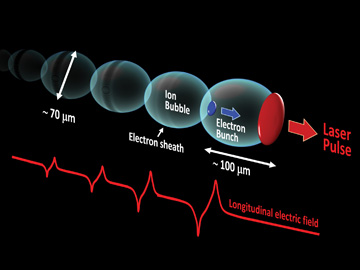 A laser wakefield accelerator uses strong laser pulses in a plasma to displace plasma electrons, forming a trail of electron plasma waves with intense local electric fields. Electrons trapped in these plasma waves are accelerated, like surfers riding the laser wakefield. [R. Torres, University of Liverpool]
A laser wakefield accelerator uses strong laser pulses in a plasma to displace plasma electrons, forming a trail of electron plasma waves with intense local electric fields. Electrons trapped in these plasma waves are accelerated, like surfers riding the laser wakefield. [R. Torres, University of Liverpool]
Laser wakefield devices don’t encounter this problem because their accelerating medium—a plasma—is already ionized (see “Laser Wakefield Accelerators: Next-Generation Light Sources,” OPN, January 2018, p. 42). The idea is to fire laser pulses lasting just a few tens of femtoseconds and with intensities of at least 1018 W/cm2 into a plasma so that the pulses push electrons aside and create a positively-charged bubble immediately behind them. With the electrons then rushing back toward the laser axis as each pulse propagates forward, a wave of positive and negative regions in the pulse’s wake creates electric fields of around 100 gigavolts per meter. Electrons either from within the plasma or injected from outside can then “surf” this wakefield to reach very high energies.
Toshiki Tajima and John M. Dawson proposed the wakefield acceleration concept in 1979, and the invention of chirped-pulse amplification a few years later enabled very intense femtosecond pulses. Since then, scientists have demonstrated plasma accelerators with ever-improving performance. In 2004, three separate groups reported “dream beams” of electrons with very narrow energy distributions. One of the groups, from the Lawrence Berkeley Laboratory Laser Accelerator center (BELLA) in California, USA, went on to accelerate electrons in two successive stages—an essential requirement for any future collider. BELLA also set the current world record in 2019 with 8 GeV of beam energy.
BELLA director Eric Esarey says that upgrades to the laboratory since mid-2020—such as an increase in laser intensity to nearly 1022 W/cm2 and a second laser beamline at the petawatt (1015 W) level—will enable “a host of new experiments,” including the staging of multi-GeV laser wakefield accelerators. But while the Berkeley group continues to strive for ever-higher energies toward the goal of a next-generation linear collider, other researchers have a more practical focus.
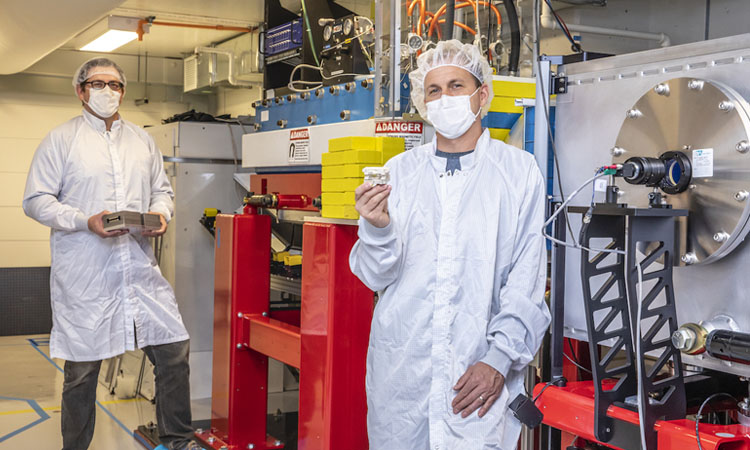 Scientists Sam Barber (left) and Jeroen van Tilborg (right) working on an electron-beam diagnostic experiment at the BELLA center in California. The tiny setup enabled measurements of electron-beam energy with range and resolution comparable to that achieved using the multi-ton dipole magnet behind them. [M. Sargent/LBNL]
Scientists Sam Barber (left) and Jeroen van Tilborg (right) working on an electron-beam diagnostic experiment at the BELLA center in California. The tiny setup enabled measurements of electron-beam energy with range and resolution comparable to that achieved using the multi-ton dipole magnet behind them. [M. Sargent/LBNL]
Maier likens most plasma accelerators developed thus far to a Formula One racing car—built to deliver record performance, but requiring high maintenance. What would make laser wakefield technology more valuable for research and industry, he argues, is instead something like a Volkswagen Beetle—a well-engineered machine that’s stable rather than extremely fast. Getting there, he says, will require taming the big fluctuations in electron beam properties caused by a nonlinear interplay of numerous laser and plasma input parameters.
“The laser can be a beast,” Maier admits. “I’m not sure what the laser gods do on a good or bad day.”
According to Carsten Welsch of the University of Liverpool, UK, confidence in beam properties will be crucial for industrial applications and even more so for medical uses—whether for diagnostics or radiation therapy. For some projects an errant shot might just be inconvenient; for others it might cause unacceptable material damage or even harm a patient. “You need a different level of reproducibility and reliability for these applications,” he says.
Aiming for the moon
Welsch is head of communications for EuPRAXIA (the European Plasma Research Accelerator with eXcellence In Applications), which aims to transform plasma accelerators into industry-ready devices. Current plans call for the generation of high-quality electron beams with energies up to 5 GeV using two types of accelerator—one powered by a laser and the other by a particle beam. Involving researchers from 16 institutes in five European countries, EuPRAXIA will include, as one application, an X-ray FEL with the goal of providing high-quality radiation to users.
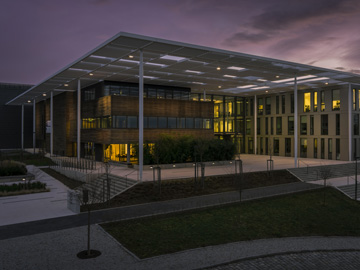 The ELI Beamlines facility near Prague, Czech Republic, is one of several candidate sites for the planned EuPRAXIA project, which hopes to translate laser-driven plasma accelerators into devices usable by industry. [ELI Beamlines Research Center]
The ELI Beamlines facility near Prague, Czech Republic, is one of several candidate sites for the planned EuPRAXIA project, which hopes to translate laser-driven plasma accelerators into devices usable by industry. [ELI Beamlines Research Center]
EuPRAXIA got a boost in 2021 when it was included on the latest European Strategy Forum on Research Infrastructures’ roadmap as one of the continent’s most important upcoming scientific facilities. It has also received nearly €100 million from the Italian government, which is due to host the particle-driven accelerator, according to Welsch. But the laser-based accelerator site has yet to be chosen, and full funding to complete the project likely remains several years away. Among the contenders for the laser facility are the ELI Beamlines laser center near Prague in the Czech Republic and the Rutherford Appleton Laboratory in Oxfordshire, UK.
Whatever facility does get picked will have a serious task on their hands, given the EuPRAXIA collaboration’s eye-watering “1003 challenge”: to build a light source delivering pulses with an energy of 100 J and a duration of 100 fs, and doing so 100 times a second. It is this last criterion—the laser’s repetition rate—that could cause a real headache (see “The need for speed,” right).
Welsch is confident that these bold targets can be met, and that EuPRAXIA could be up and running by around 2030. He says meeting all three of the 1003 targets would “mark a major breakthrough,” and likens the challenge to American president John F. Kennedy’s goal to put a man on the moon by the end of the 1960s, as well as Ernest Rutherford’s precise stipulation for the accelerator potential (about 10 million V) needed to split the atom.
The need for speed
Generating intense laser pulses at repetition rates of hundreds or even thousands of times a second will be crucial for many applications of plasma accelerators. To date, however, high-power lasers generally operate at no more than a few Hz.
That limit is set by the (high-bandwidth) lasing material needed for pulse compression (generally titanium-sapphire) and the associated pumping source (flashlamp-pumped Nd:YAG and Nd:glass lasers). The pump lasers’ low efficiency means they consume lots of electricity while imposing a high thermal load on the laser crystals and other optical components. The repetition rate is low because it takes time to dissipate that heat.
One possible solution is to use laser diodes—far more efficient than flashlamps—for the pumping. But high-power devices are still quite expensive. According to Chang Hee Nam, director of the Center for Relativistic Laser Science (CoReLS) in South Korea, mass production of high-power laser diodes might take another ten years, though major funding for laser fusion research, for example, could speed things up.
An alternative path to high repetition rates is replacing Ti:Sa media with fiber lasers. These are efficient and cheap but have low peak powers, so the idea is to coherently combine the output from multiple devices. A European collaboration known as the International Coherent Amplification Network merged the light from 64 fiber lasers in 2013, while scientists at the BELLA center in California and the University of Michigan, USA, aim to combine laser pulses in both time and space. But they have their work cut out, given that thousands of pulses will have to be merged in a working plasma accelerator.
Others, however, have their doubts. Jerome Faure of the Polytechnic Institute of Paris in France reckons additional research will be needed to reach this level of performance. He contrasts EuPRAXIA with a more modest project he and technology company Thales are developing: building a plasma accelerator with a 100-Hz repetition rate and a 100-fs pulse duration, but a pulse energy of just 1 J. “Increasing the energy by another factor of 100 is a very big challenge,” he says. “Relying on this as the building block of your project is a bit risky.”
Stable but not super-stable
Another group taking a more bottom-up approach is Maier’s at DESY. Since appointing plasma accelerator expert Wim Leemans as head of the accelerator division in 2019, Maier says, the lab has focused on transforming wakefield accelerators from a concept into a real-world technology.
In that vein, he and his colleagues have set out to gradually improve the performance of their accelerator, known as LUX. They became one of the first groups to exploit machine learning for this end, which narrowed the energy spread of LUX’s electrons and enabled the machine to tune itself autonomously (see “Plasma autopilot,” p. 28). But there is still work to do, with fluctuations in parameters such as the laser focus preventing optimal beam properties for most shots. “The laser can be a beast,” Maier admits. “I’m not sure what the laser gods do on a good or bad day.”
The DESY researchers will now use all their data to pin down the cause of the shot-to-shot fluctuations to enhance the stability of their beam’s energy and its spread—currently standing at a few parts per hundred—by about a factor of ten. While that’s an apparently modest goal compared with what Maier calls the “insane” stabilities of RF cavities at conventional accelerators, achieving it would yield a “useful beam” for a number of applications, he reckons.
For example, he says, laser wakefield devices may be used as slimmed-down injectors for traditional synchrotron storage rings—providing stable electron beams 24 hours a day. Another potential application could be non-destructive testing, which would involve directing accelerated electrons at a laser beam to produce high-energy X-rays via Compton scattering. The X-rays could be used to look for defects within a metal, for example, or to scan vehicles for the presence of nuclear materials.
Laser wakefield accelerator research using the Gemini laser at the UK’s Rutherford Appleton lab. The purple/pink column on the left is the plasma, about 2 cm long. The blue light to the right, emitted by the interaction, is reflected off one of the magnets used to steer the electron beam. [B. Kettle]
Plasma autopilot
Tuning a laser wakefield accelerator manually is a painstaking task, which is why some groups are getting help from artificial intelligence. Andreas Maier and colleagues at DESY showed in 2020 that by running their LUX accelerator continuously for 24 hours and firing one shot every second, they could stabilize their beam parameters to some extent. However, those parameters were not optimal—the beam spread, in particular, being more than 10 times greater than it would be ideally.
The group responded by using Bayesian optimization to create a function representing the value of the machine’s energy spread within a five-dimensional input parameter space—accounting for the laser energy, laser focus position and three flow rates regulating the plasma composition. The idea was to fire a laser shot, measure the energy spread of the accelerated electrons and feed that information back to their computer. By modifying the function to better reflect the measured value, the computer then selected new input parameters corresponding to the function’s revised minimum—leading the energy spread on some shots to drop below 1%.
A UK-led collaboration has carried out similar work, using Bayesian optimization to improve the output of a plasma accelerator and X-ray generator at the Rutherford Appleton Laboratory in Oxfordshire. The researchers used a series of completely autonomous steps to optimize as many as six input parameters, including the laser’s spatial and temporal profile as well as the plasma density. With about 50 iterations in just under half an hour, they boosted the X-ray yield by a factor of five and could then use the radiation for imaging.
Group member Stuart Mangles of Imperial College in London says that such an automated process could in future optimize accelerators without an expert operator. “That will be important for laser wakefield accelerators to become more widespread,” he says.
Faure agrees that non-destructive testing would have commercial appeal, particularly if laser repetition rates can be improved. He says directing electrons at a piece of foil made from tungsten or another heavy metal and tapping the X-rays from Bremsstrahlung radiation could achieve this. Such a source, he estimates, could be housed in a box 2 meters on a side, allowing it to be transported in a truck. “This is perhaps the most promising application of plasma accelerators for industry,” he says.
Culture change
Researchers are also looking to exploit the unique qualities of plasma accelerators—in particular, their femtosecond pulse lengths, some three orders of magnitude shorter than those from synchrotron sources. This makes the radiation they produce, including betatron radiation naturally emitted by electrons following a curved path through the plasma, well suited to studying very fleeting processes. Among these are matter forced out of equilibrium under temperature and pressure extremes, such as those occurring at the centers of planets.
Félicie Albert at the Lawrence Livermore National Laboratory in California, USA, already uses plasma accelerators to investigate such processes, by pumping samples with pulses from a very powerful laser or FEL and then probing the response with X-rays from a wakefield device. Using a plasma accelerator instead of a conventional RF machine, Albert says, allows both briefer snapshots and more flexibility in co-locating laser and X-ray source.
As to more demanding applications of plasma accelerators, experts appear to agree that a next-gen linear collider is still probably decades away. Indeed, the US Department of Energy’s 2016 roadmap foresaw that construction of such a facility would not begin until around 2040. Chang Hee Nam of CoReLS in South Korea points out that current plans call for a 1 TeV collider to be made up of 100 stages, each of 10 GeV. But he says that having a separate petawatt-class laser at each stage, requiring perhaps 10 people to operate and maintain it, “would be a nightmare.”
Scientists are generally upbeat about a plasma-based X-ray FEL, though differences remain.
Scientists are generally upbeat about a plasma-based X-ray FEL, though differences remain. Shanghai group head Ruxin Li says much work is still needed, given the sensitivity of the lasing process to energy spread and beam divergence, though he reckons that such a device could be operating in universities and hospitals within about a decade.
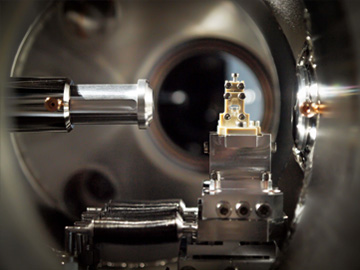 A terawatt-class laser pulse coming from the left is focused into the hydrogen-filled plasma cell (center) of DESY’s LUX accelerator. [N. Delbos, University of Hamburg]
A terawatt-class laser pulse coming from the left is focused into the hydrogen-filled plasma cell (center) of DESY’s LUX accelerator. [N. Delbos, University of Hamburg]
Albert is also confident that plasma-based FELs will become a reality, although she thinks that it will take at least 5 to 10 years before they are used for scientific research. Betatron radiation, she adds, could be employed sooner for medical imaging. Maier thinks that the first user facility will operate at soft- rather than hard-X-ray wavelengths, while Faure remains cautious. “I would give it 10 years and see what happens,” he says.
Faure argues that laser plasma accelerators will become common in science and industry once researchers start to dedicate themselves to machine building. Calling for “a change of culture in our field,” he argues that his colleagues need to move on from performing physics experiments—although he concedes that the imperative to publish results in journals will likely hinder this aim.
As to what kind of machines should be built, Welsch has no doubt that a major change in technology is needed—and that EuPRAXIA will bring that change. Maier instead is looking to build on his existing technology, aiming to construct a new laser system that will incorporate the “lessons learned” from his group’s experiments to date. As to exactly when they might have an accelerator with sub-percent stability, he concedes that “things always take longer than you think.” His best estimate: “In the next three to five years.”
Edwin Cartlidge is a freelance science writer based in Rome, Italy.
References and Resources
-
A. J. Gonsalves et al. “Petawatt laser guiding and electron beam acceleration to 8 GeV in a laser-heated capillary discharge waveguide,” Phys. Rev. Lett. 122, 084801 (2019).
-
EuPRAXIA conceptual design report, www.eupraxia-project.eu (2020).
-
R.J. Shalloo et al. “Automation and control of laser wakefield accelerators using Bayesian optimization,” Nat. Comm. 11, 6355 (2020).
-
F. Albert et al. “2020 roadmap on plasma accelerators,” New J. Phys. 23, 031101 (2021).
-
S. Jalas et al. “Bayesian optimization of a laser-plasma accelerator,” Phys. Rev. Lett. 126, 104801 (2021).
-
W. Wang et al. “Free-electron lasing at 27 nanometres based on a laser wakefield accelerator,” Nature 595, 516 (2021).

